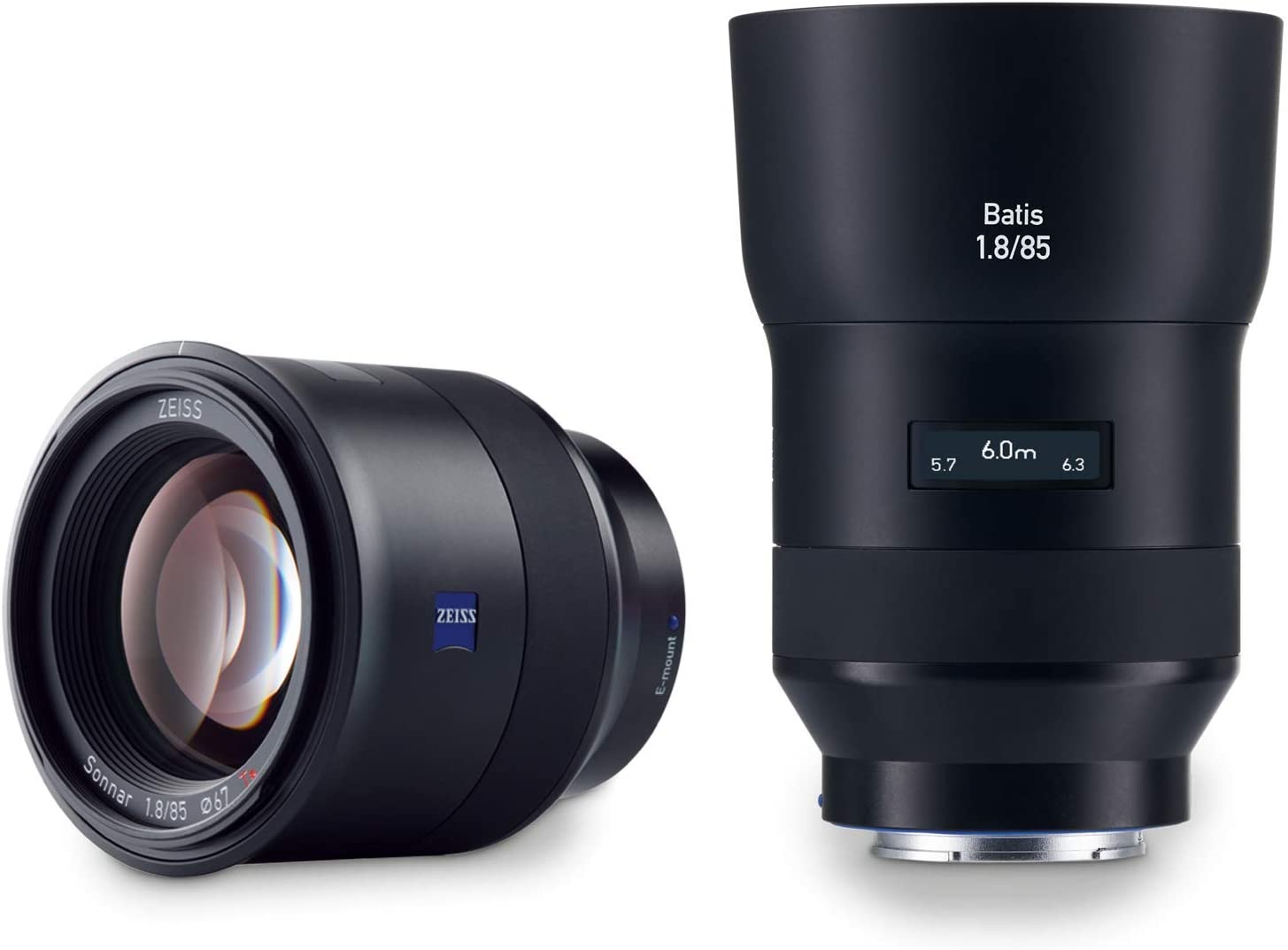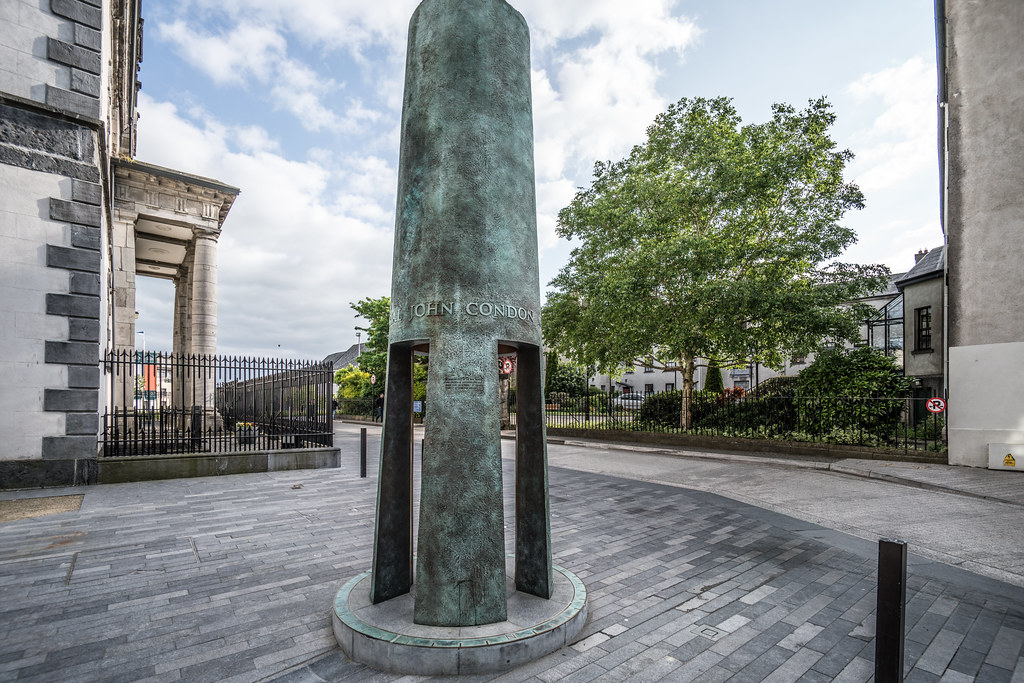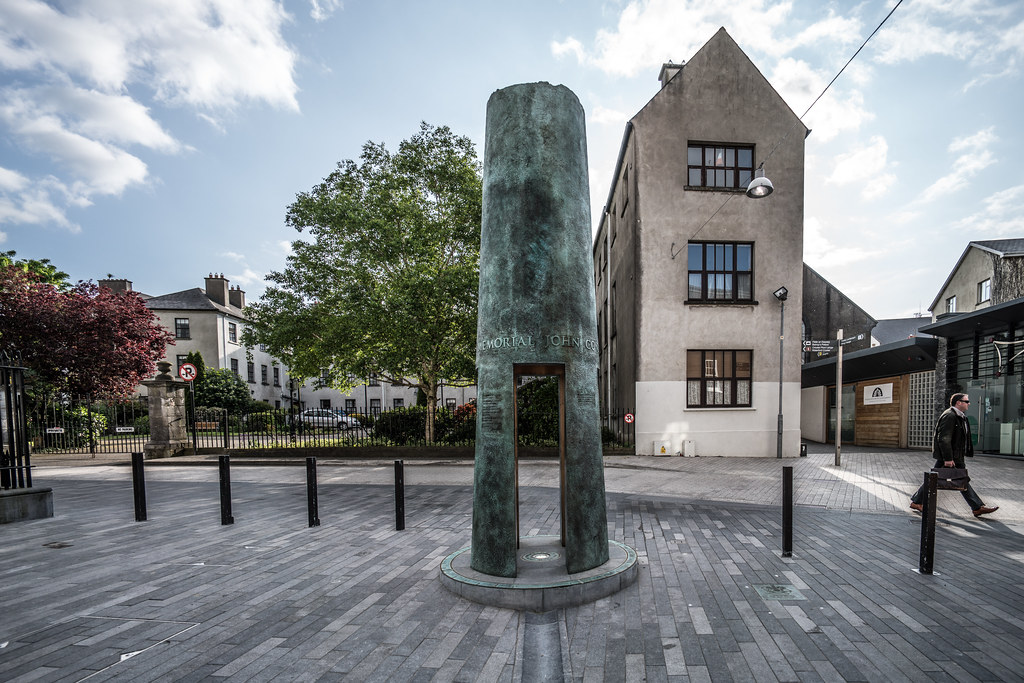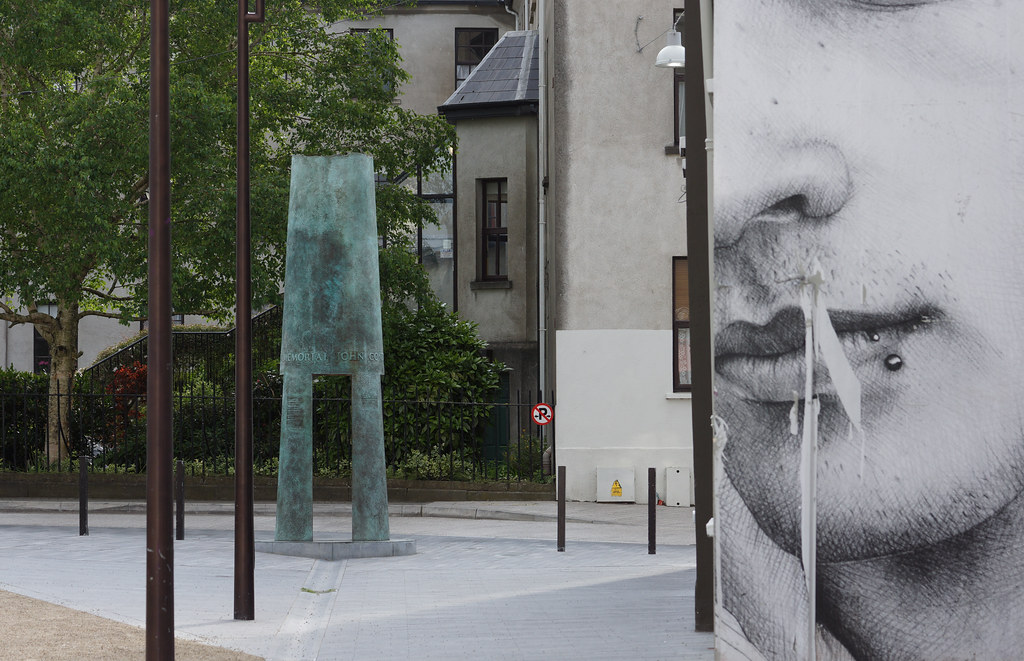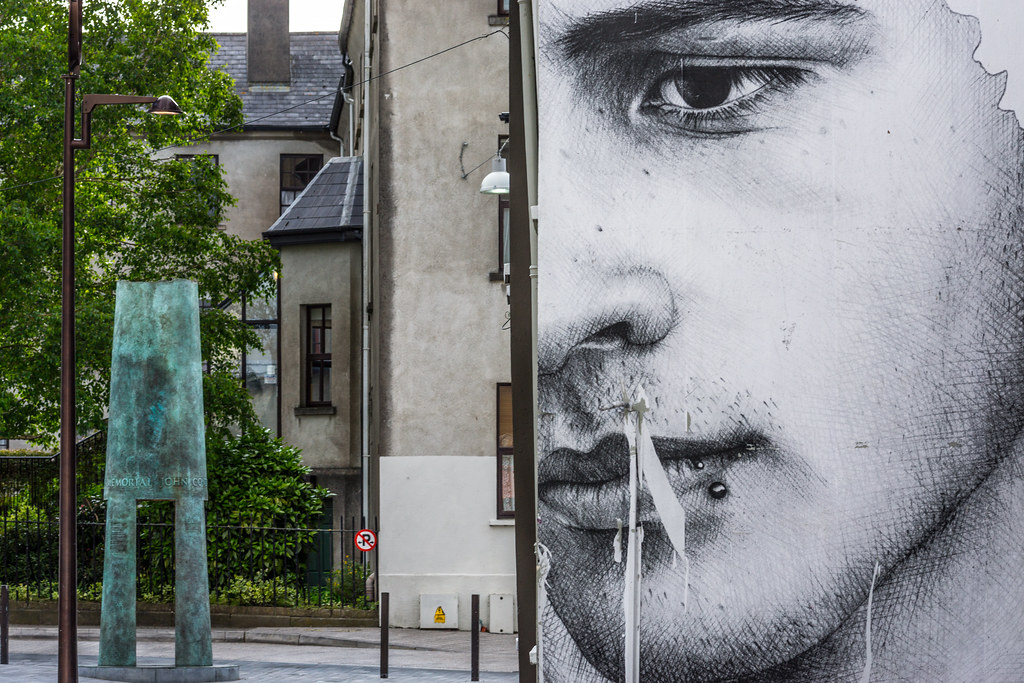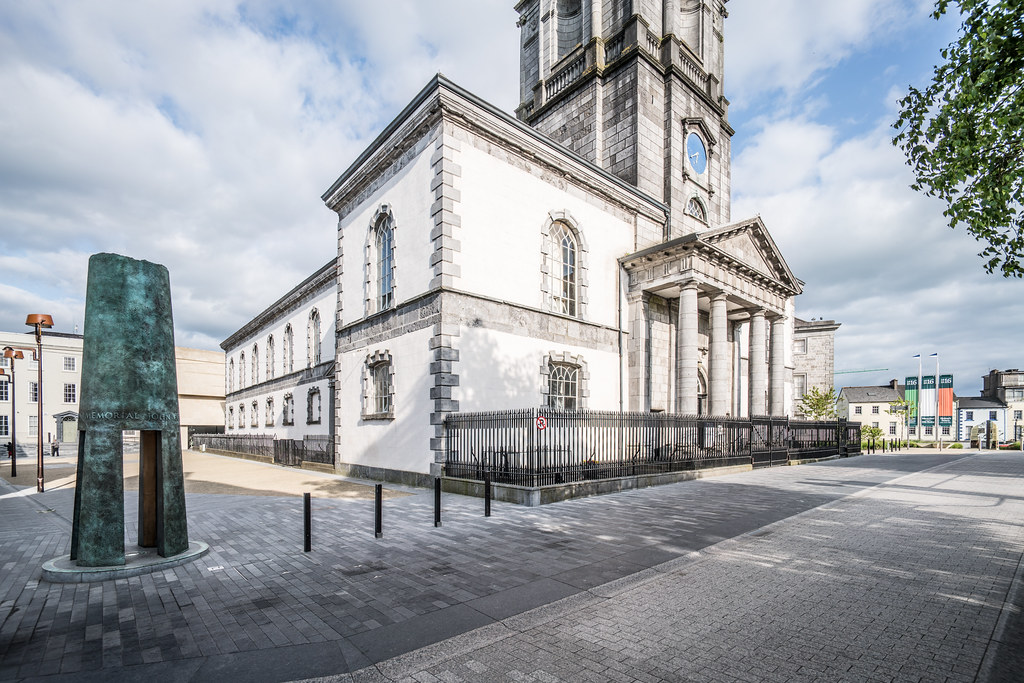
Custom Search
THE GREEN MENU OPTIONS ARE MOBILE FRIENDLY AND ARE FASTER SO THEY ARE RECOMMENDED. THE RED MENU OPTIONS ARE SOMEWHAT SLOWER DEPENDING ON YOUR DEVICE OR BROWSER AND ARE MORE SUITABLE FOR DESKTOPS AND LAPTOPS. THE BLUE OPTIONS ARE PAGE LINKS AND WILL BE PHASED OUT GOING FORWARD
JOHN CONDON MEMORIAL
The John Condon Memorial was unveiled at Cathedral Square on Sunday 18 May 2014. Created by Artist Pat Cunningham, the sculpture stands over four metres in height and is now positioned on the Western side of Cathedral Square, in Waterford City’s Viking Triangle. It is named in honour of the youngest recorded Allied soldier killed in the First World War, Private John Condon, from Wheelbarrow Lane, Ballybricken.
Known as the ‘Boy Soldier’, Private Condon was killed in the Second Battle of Ypres, Belgium, on 24 May 1915 at just fourteen years of age. His final resting place is the British war cemetery at Poelcapelle in Belgium.
Known as the ‘Boy Soldier’, Private Condon was killed in the Second Battle of Ypres, Belgium, on 24 May 1915 at just fourteen years of age. His final resting place is the British war cemetery at Poelcapelle in Belgium.
SORRY FOR THE DELAY
It is estimated that in excess of 400,000 Irishmen fought in World War I. This figure includes those serving in the regular British army in 1914 as well as those who volunteered for service in the new Irish divisions formed following the outbreak of the war, the 10th, 16th and 36th, as well as Irishmen serving in the armed forces of other Commonwealth nations. Roughly 4,800 men from Waterford city and county served and over 700 were killed.
Private John Condon was killed in the Second Battle of Ypres, Belgium, on 24 May 1915. Known as the ‘Boy Soldier’, he was only 14 years of age when he was killed and is recorded as being the youngest British soldier to have died in the Great War. Condon’s grave in Flanders is one of the most visited of all the war graves and is regarded by many as a fitting symbol for the futility of war.
John Condon was born in the parish of Trinity Without in Waterford City. His parents were John and Catherine Condon of Thomas’ Avenue, also known as Wheelbarrow Lane, off Barker Street. This lane was closed by Waterford City Council in the 1960s.
John Condon enlisted in the 3rd Battalion of the Royal Irish Regiment at Waterford on 24 October 1913. This was a reserve battalion composed of soldiers who served on a part-time basis but were liable to be called up for regular service in the event of mobilisation. He gave his date of birth as 24 October 1895 which would have made him eighteen on enlistment. However, it is believed that could only have been about twelve at the time.
Following enlistment he officially began his training as a recruit, completing this on 23 February 1914, when he was released home. He was recalled for further training two months later on 18 April completing this on 17 May, when he was again released.
On the outbreak of World War I John Condon was mobilised on the 7 August. However, as he was 'officially' still only aged eighteen, he remained with the reserve battalion in Ireland until after his 'official' nineteenth birthday on 24 October, as the army had fixed the minimum age for service overseas at nineteen. On 28 November John Condon committed his only offence on an otherwise spotless military record, ‘being in a dirty state for 2 pm parade’ and ‘absenting himself from his barrack room when orderly man’. As punishment he was confined to barracks for four days.
On 16 December 1914, nearly two months after his 'official' nineteenth birthday he was drafted to the 2nd Battalion of the Royal Irish Regiment. The battalion was posted to France at the outbreak of hostilities as part of the 4th Infantry Division in the British Expeditionary Force and in December was holding part of the line in the Ypres Salient on the Western Front.
The battalion was in action during the series of engagements which became known as the Second Battle of Ypres from the 22 April – 25 May 1915 when the German army launched a series of attacks on the salient using poison gas for the first time.
On the early hours of 24 May 1915, the Germans commenced a heavy artillery attack followed by clouds of lethal chlorine gas along a 4.5-mile front, part of which was held by the 2nd Battalion. John Condon was among the casualties of this attack on the second last day of the battle. He was buried on the battlefield in a temporary grave near St Julien.
2nd Battalion Royal Irish Regiment, War Diary, 24th May 1915
2.00 am Trenches: Battalion stood to arms.
2:20 am Trenches: The enemy, preceded by gas, attacked. A mild wind blowing from the north-east brought the full volume of the gas on that part of the line occupied by the battalion. Although every step regarding the use of respirators and sprayers was taken, many of all ranks were overcome by gas. Shell Trap Farm, which had been held by 2 platoons of the 2nd Battalion Royal Dublin Fusiliers, was taken by the enemy, thus enabling them to enfilade our position of the line, which they worked down bombing us with hand grenades. The enemy took our trenches down as far as the right of the ‘King's Own’, only a few men of our battalion now being left. Here the attack was checked, the enemy holding the ground he had taken, two platoons of A Company, under the command of Lieut. McKay, 4th Connaught Rangers, who were in support at point A on map, held on until the following morning. Our casualties were 17 Officers and 378 other ranks, Approx.
After the war his body was recovered and reburied at Poelkapelle, about five miles north east of Ypres. The stone over his grave bears the inscription: 9322 Private J. Condon Royal Irish Regiment 24th May 1914 age 14
John Condon is recorded in the Commonwealth War Graves Commission records as follows: In Memory of Private JOHN CONDON 6322, 2nd Bn., Royal Irish Regiment who died age 14 on 24 May 1915 Son of John and Mary Condon, of Waterford. Youngest known battle casualty of the war. Remembered with honour POELCAPELLE BRITISH CEMETERY
Private John Condon was killed in the Second Battle of Ypres, Belgium, on 24 May 1915. Known as the ‘Boy Soldier’, he was only 14 years of age when he was killed and is recorded as being the youngest British soldier to have died in the Great War. Condon’s grave in Flanders is one of the most visited of all the war graves and is regarded by many as a fitting symbol for the futility of war.
John Condon was born in the parish of Trinity Without in Waterford City. His parents were John and Catherine Condon of Thomas’ Avenue, also known as Wheelbarrow Lane, off Barker Street. This lane was closed by Waterford City Council in the 1960s.
John Condon enlisted in the 3rd Battalion of the Royal Irish Regiment at Waterford on 24 October 1913. This was a reserve battalion composed of soldiers who served on a part-time basis but were liable to be called up for regular service in the event of mobilisation. He gave his date of birth as 24 October 1895 which would have made him eighteen on enlistment. However, it is believed that could only have been about twelve at the time.
Following enlistment he officially began his training as a recruit, completing this on 23 February 1914, when he was released home. He was recalled for further training two months later on 18 April completing this on 17 May, when he was again released.
On the outbreak of World War I John Condon was mobilised on the 7 August. However, as he was 'officially' still only aged eighteen, he remained with the reserve battalion in Ireland until after his 'official' nineteenth birthday on 24 October, as the army had fixed the minimum age for service overseas at nineteen. On 28 November John Condon committed his only offence on an otherwise spotless military record, ‘being in a dirty state for 2 pm parade’ and ‘absenting himself from his barrack room when orderly man’. As punishment he was confined to barracks for four days.
On 16 December 1914, nearly two months after his 'official' nineteenth birthday he was drafted to the 2nd Battalion of the Royal Irish Regiment. The battalion was posted to France at the outbreak of hostilities as part of the 4th Infantry Division in the British Expeditionary Force and in December was holding part of the line in the Ypres Salient on the Western Front.
The battalion was in action during the series of engagements which became known as the Second Battle of Ypres from the 22 April – 25 May 1915 when the German army launched a series of attacks on the salient using poison gas for the first time.
On the early hours of 24 May 1915, the Germans commenced a heavy artillery attack followed by clouds of lethal chlorine gas along a 4.5-mile front, part of which was held by the 2nd Battalion. John Condon was among the casualties of this attack on the second last day of the battle. He was buried on the battlefield in a temporary grave near St Julien.
2nd Battalion Royal Irish Regiment, War Diary, 24th May 1915
2.00 am Trenches: Battalion stood to arms.
2:20 am Trenches: The enemy, preceded by gas, attacked. A mild wind blowing from the north-east brought the full volume of the gas on that part of the line occupied by the battalion. Although every step regarding the use of respirators and sprayers was taken, many of all ranks were overcome by gas. Shell Trap Farm, which had been held by 2 platoons of the 2nd Battalion Royal Dublin Fusiliers, was taken by the enemy, thus enabling them to enfilade our position of the line, which they worked down bombing us with hand grenades. The enemy took our trenches down as far as the right of the ‘King's Own’, only a few men of our battalion now being left. Here the attack was checked, the enemy holding the ground he had taken, two platoons of A Company, under the command of Lieut. McKay, 4th Connaught Rangers, who were in support at point A on map, held on until the following morning. Our casualties were 17 Officers and 378 other ranks, Approx.
After the war his body was recovered and reburied at Poelkapelle, about five miles north east of Ypres. The stone over his grave bears the inscription: 9322 Private J. Condon Royal Irish Regiment 24th May 1914 age 14
John Condon is recorded in the Commonwealth War Graves Commission records as follows: In Memory of Private JOHN CONDON 6322, 2nd Bn., Royal Irish Regiment who died age 14 on 24 May 1915 Son of John and Mary Condon, of Waterford. Youngest known battle casualty of the war. Remembered with honour POELCAPELLE BRITISH CEMETERY
Commercial DisclosurePLEASE NOTE THAT LINKS BELOW MAY REDIRECT YOU TO THE AMAZON LOCATION MOST LIKELY TO SHIP TO YOUR ADDRESS
You will find links to buy products from Amazon, Google and other partners. If you click on these links, you’ll find that the URL includes a small extra piece of text which identifies that the click came from my websites. This text is an affiliate code, and it means that I get a small percentage of the money you spend if you choose to buy that product, or, in some cases, other products from the site soon after. These affiliate links help pay the costs of producing my websites and ensure that the content is free to you.
